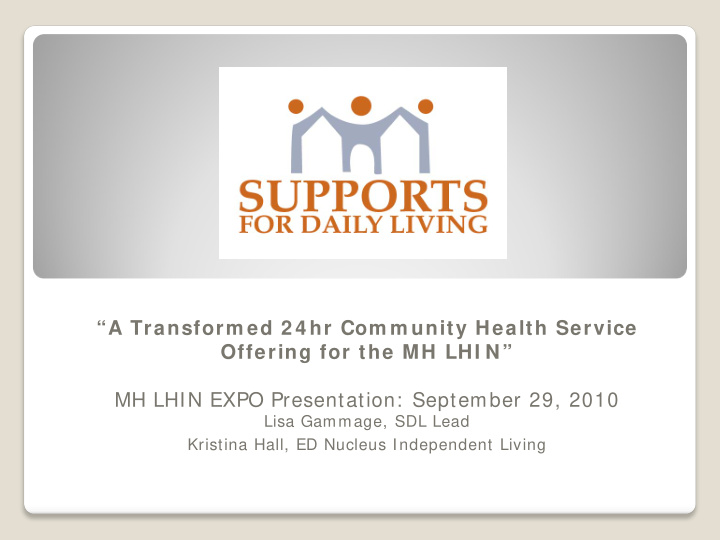



“A Transform ed 2 4 hr Com m unity Health Service Offering for the MH LHI N” MH LHIN EXPO Presentation: September 29, 2010 Lisa Gammage, SDL Lead Kristina Hall, ED Nucleus Independent Living
MICBA Forum Italia Community Services Nucleus Independent Living Oakville Senior Citizens Residence (OSCR) Ontario March of Dimes (OMOD) Peel Senior Link (PSL) Regional Municipality of Halton Victorian Order of Nursing (VON) Peel Yee Hong Centre for Geriatric Care “This collaborative effort among our eight approved SDL Providers provided an excellent opportunity to maximize our ability to improve support for our seniors,” Bill MacLeod, CEO Mississauga Halton LHIN. 8 Approved SDL Providers
Service Features: • Personal care and associated light homemaking to assist with essential activities of daily living • Also safety checks, reminders and urgent response • Multiple daily visits by trained PSWs anytime throughout 24hr period • Scheduled and on-call availability 365 days per year Targeted Population: • Frail seniors over the age of 65 (minimum assessment score) • Reside at home within Oakville, Mississauga and Southwest Etobicoke within MH LHIN boundaries Transformation: • Previous Supportive Housing framework was redesigned to expand geographical access to service and eliminate low income housing requirement as means to access service • Result is 3 models of service operation (“in building”, “hub/ spoke”, “mobile”) • Standardized service offerings and hours of care among all providers SDL Service Transform ation
Outcom es on Hospitals Goals & • 55 ALC clients taken out of hospital Outcom es • 161 patients accepted to SDL directly • 1,189 ER visits diverted 2 0 0 9 – Jun 2 0 1 0 • 379 clients returned back from hospital sooner • Over 1365 patient days reduced Reduce acute care and ALC pressures Reduce unnecessary ED Outcom es on LTC Hom es visits of target seniors • 13 left LTC homes to SDL • 191 clients diverted from going to LTC Avert unnecessary ED • 296 LTC Spots no longer needed admissions Divert premature LTC placement Outcom es for the HC System Admit/ Discharge SDL • 1,701 clients being served clients at the right time • Cost to the system reduced • $5.3Million Net savings • Client Satisfaction-aging at home
Designed and implemented with high-level systems view Designed to improve outcomes for seniors based on identified needs and interests (i.e. preference to age at home, need for frequency etc.) Designed and coordinated collectively by providers with MHLHIN support Strategic investments (i.e. population density, geographical proximity etc.) Systems level cost savings (alternatives to existing solutions – ALC, LTC etc.) Use of Common Assessment Tool (InterRAI-CHA) to ensure appropriateness (right care, right place, right time) Centralized information and referral pathway (easy navigation for referrals sources) Responsive to system demands (hospital pressures etc.) Strong ‘customer service’ focus – (referral sources as “customers”) Changed from housing focus to service needs Standardized delivery of services (approved SDL providers) Innovative service offerings within model (Hub/ Spoke, SDL Mobile) Clear performance measures and deliverables (system level) Factors of Success
Focus support on early adopters – they are the drivers for change Being agile is a key to success in today’s rapidly changing landscape Know your “customer”, their pressures and needs and deliver accordingly Innovation is born through the acknowledgement of what’s not working Greatest Learnings
SDL GAPS Opportunities: Gaps: • Enhancement of services •Demand vs. Capacity offered • Linking to more prevention •Isolated in planning or wellness strategies from larger healthcare partners • Linking to volunteer (i.e. Hospitals and supports CCAC) • Targeting increased support for “hard to serve/ •Untapped potential hard to place” clients (i.e. Other mobile healthcare solutions • Potential for greater etc.) interconnectiveness between different segments of the healthcare continuum
Breaking New s: SDL Mobile becom ing Transitional Service • Purpose is to leverage SDL Mobile’s flexibility and responsiveness to optimize hospital discharge of SDL appropriate patients • Discharging clients to more appropriate services following period of stabilization on SDL Mobile’s transitional program (includes to other SDL Providers) Changes include: • No waitlist for hospital SDL appropriate referrals • Upstream involvement in hospital SDL referral process • Planning for hospital surges etc. • Greater interconnectedness between SDL, CCAC’s and CSS providers: • Pull strategy development • Priority referral placements • Service enhancements • Shared Services – hard to place, hard to serve • Developed SDL Mobile Client discharge pathways • Manage flowthrough with pathway LOS targets • Implement Admission, Discharge and Transfer (ADT) strategies
“The Mississauga Halton LHIN’s Supports for Daily Living program is exactly the type of innovative thinking that is needed across the province . It will allow Ontario’s seniors to live in the comfort of their own home for as long as possible resulting in saved health care dollars,” Kevin Flynn, MPP Oakville. “The success of the MH LHI N’s Supports for Daily Living( SDL) program , launched in 2008-09, continued and enhanced throughout 2009 and 2010, provides help and support to our frail seniors, enabling them to continue living safely in their own homes” Bill MacLeod, CEO, MH-LHI N Opinions
Recommend
More recommend